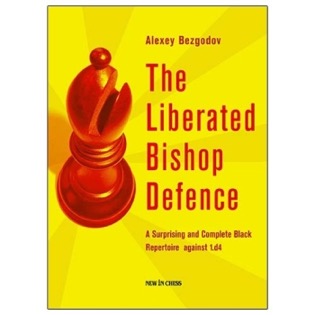Liberated Bishop Defense, The
Alexey Bezgodov

THE LIBERATED BISHOP DEFENSE by Alexey Bezgodov is devoted to an opening variation that may be familiar to many as the Baltic Defense (1.d4 d4 2.c4 Bf5 and 1.d4 d5 2.Nf3 Bf5). This is the first detailed work devoted to this complete answer to 1.d4, and Russian Grandmaster Bezgodov uses 100 deeply annotated model games to explain the opening and 103 exercises to test what the readers has learned. There are also short bonus chapters at the end of the book. One is devoted to the gambit line 1.d4 d5 2.Nf3 Bf5 3.c4 e6 4.Nc3 Nf6 5.cxd5 exd5 6.Qb3 Nc6 7.Bg5 Be7!? (in the main body of the book 7…Na5 is examined) and the other is a tribute to David Bronsteins use of this opening.
Most of the Grandmaster games with 2… Bf5 come from the sequence 1.Nf3 d5 2.d4 (2.c4 d4 is considered by many top players to be fine for Black who has a space advantage at move two) 2…Bf5. The more direct 1.d4 d5 2.c4 Bf5 is not seen as often. Trying to punish to the early bishop foray with 3.Qb3 is met by 3…e5 which leads to sharp and interesting play. The author notes that this is not the reason 2…Bf5 isnt seen more often. Instead, what keeps more players trying 1.d4 d5 2.c4 Bf5 is 3.cxd5. After 3…Bxb1 4.Qa4+ Qd7 5.Qxd7+ Nxd7 6.Rxb1 or 4…c6 5.dxc6 Nxc6 6.Rxb1 Qxd4 7.Qxd4 Nxd4 the queens come off the board and the first player has the potential advantage of the two bishops. Bezdodov makes a case that these endings are not dangerous for Black if he knows what he is doing. He quite correctly points out that many Black defenses which are much more popular, have problems of this nature if not worse.
Unlike many other answers to 1.d4, Black rarely suffers from having a bad piece after 2…Bf5. The heart and soul of this book are the annotated games. One that brought back memories for this reviewer was number 19 played between Igor Ivanov and Vladimir Mezentsev at the Mechanics Institute Chess Club in 2000. The opening is an example of how not to play for White as 5.Nf3 is a mistake and after 5…Nb4! the first player is already in trouble. Bezgodov attributes Igors mistake to mixing up variations. What he couldnt know is that Igor, who frequently worshiped in honor of Dionysus, arrived at the game in a well-lubricated state.
Once Black played 5…Nb4! Ivanov went into deep thought and started playing with incredible imagination. What followed has to be one of the more entertaining games of chess ever played. Bezgodovs devotes six pages to this epic battle in which the advantage repeatedly passed back and forth. Ivanov, who fell asleep at one point in the game for several minutes, eventually ran out of gas (he missed a clear win with 35.c7!), but this game does great credit to both players. The abbreviated notes are from Bezgodov.
Igor Ivanov – Vladimir Mezentsev, San Francisco 2000
1.d4 d5 2.c4 Bf5 3.Nc3 e6 4.Qb3 Nc6 5.Nf3?! Nb4! 6.e4 dxe4 7.c5 a5 8.a3 exf3! 9.axb4 Qxd4?!
9…axb4!
10.Be3 Qd7 11.bxa5 c6 12.Na4?! Rxa5 13.Rd1 Qc7 14.g4? Bg6?
14…Bxg4
15.Qb4 b5?! 16.Nc3 Be7 17.Nxb5?!
17.Bxb5!
17…cxb5 18.Bxb5+ Kf8 19.Rd7 Ra1+?? 20.Kd2 Qa5 21.Qxa5 Rxa5 22.Rb7 Ra8 23.Ra1 Rd8+ 24.Rd7 Rxd7+ 25.Bxd7 Be4 26.Ra4 Bd5 27.c6 Bd6 28.Kc3 Ke7 29.Ra8 Bxh2?!
29…Be5+ 30.Kd3 Kd6 31.Ra5 Ke7 32.Ra8 Kd6, =.
30.Bc5+ Kf6 31.b4 Kg5 32.Bd4 f6 33.b5 Kxg4 34.b6 h5 35.b7??
35.c7! wins.
35…h4 36.b8=Q Bxb8 37.Rxb8 h3 38.c7 h2 39.c8Q h1=Q 40.Bxe6+ Bxe6 41.Qxe6+ Kh5 42.Qf5+ g5 43.Rb1 Qg2 44.Re1
44.Qc8! Qh2 45.Re1!
44…Nh6 45.Qxf6 Rc8+ 46.Kd2 Qh3 47.Re6 Qf5 48.Qxh6+ Kg4 49.Qg6 Qa5+ 50.Kd3 Qb5+ 51.Ke4 Rd8 52.Rd6 Re8+ 53.Re6 Rf8 54.Be3 Rf5 55.Bxg5?
55.Rd6! Qa4+ 56.Rd4 Qc2+ 57.Rd3 draws.
55…Rxg5 56.Qe8 Qe2+ 57.Kd4 Qxf2+ 58.Re3 Qd2+ 59.Kc4 Qd5+ 60.Kc3 Qa5+ 61.Kd4 Qc5+, 0-1.
One major revelation for this reviewer is that after 1.d4 d5 2.Nf3 Bf5 3.c4 e6 4.Nf3 Blacks best move is not 4… c6 and that 4 …Bb4, 4… Nc6 and 4 …Nf6 are all quite playable. Surprisingly 2… Bf5 can be quite transpositional with play developing along paths analogous to the Albin, Chigorin and Ragozin defences.
THE LIBERATED BISHOP DEFENSE fills a void in chess literature and can be strongly recommended to anyone interesting in taking up this answer to 1.d4.
